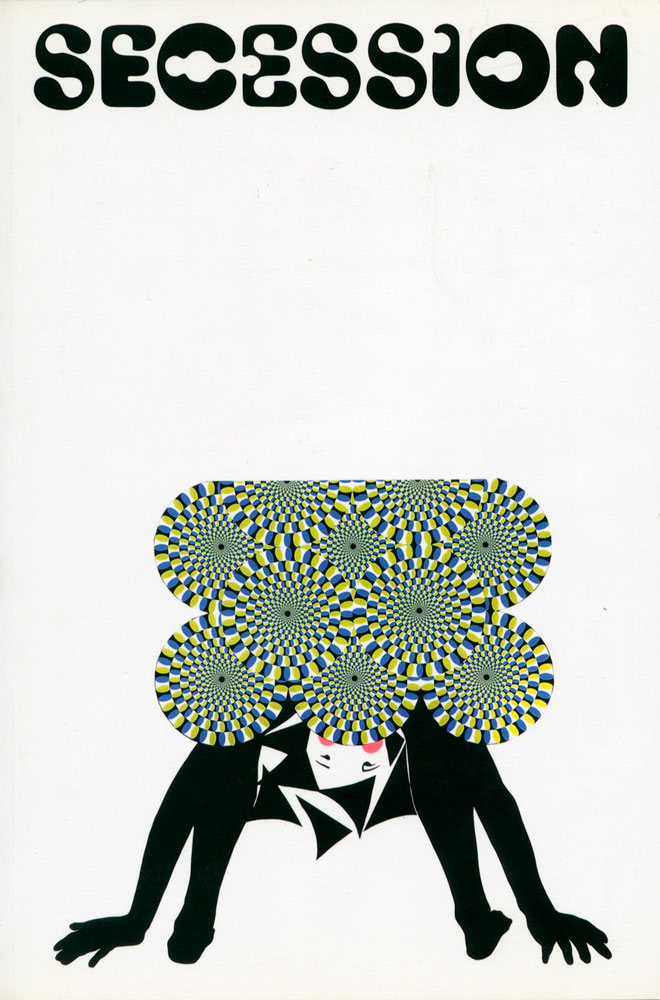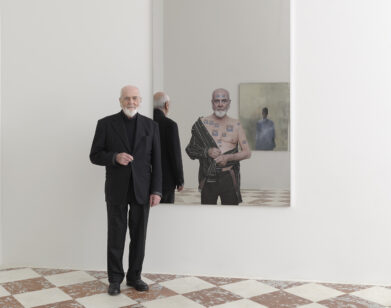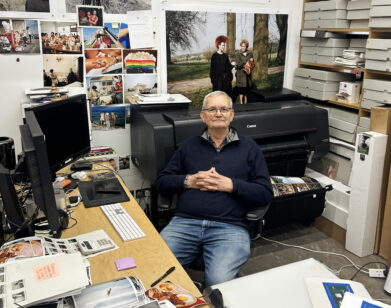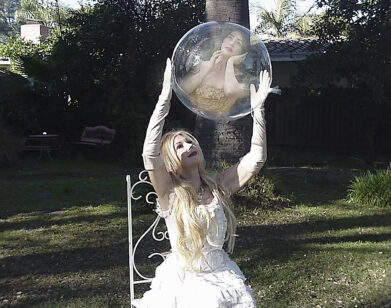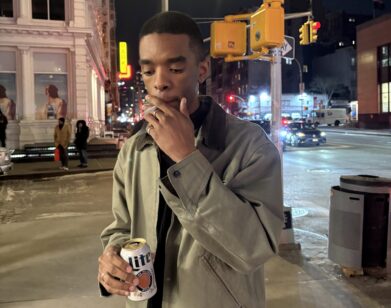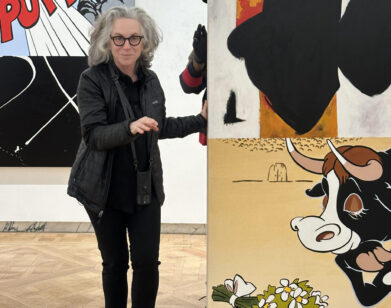Mozart for the Modern Age
FRANCES STARK IN VENICE, ITALY, MAY 2015. PORTRAIT BY CARL J ASQUINI. SPECIAL THANKS: KODAK ALARIS.
Before seeing the breadth of her website, mixed media artist, poet, and prose writer Frances Stark presents the viewer with an ironic selfie and a quote from Hans-Ulrich Obrist: “@therealstarkiller is a little angry, a little creepy, very humorous, and totally brilliant.” And somehow, this simple sentence manages to say it all.
Stark, who is based in Los Angeles, creates animated movies, paintings, drawings, and collages that propose critical subject matter—such as the current state of media and its implications—and are almost always presented with a humorous tone. She has inscribed texts by notable writers like Emily Dickinson, Goethe, and Samuel Beckett within her two-dimensional works, but has also made amateur animated movies, one of which was composed of conversations and encounters she had via an online sexcam.
With solo shows and as a participant in the 2008 Whitney Biennial, the Performa 11 biennial, and the 54th Venice Biennale, Stark has exhibited around the world. Today, her solo show of new work opens at Greengrassi in London, and later this year she will present a comprehensive survey of 25 years of work at the Hammer Museum in L.A. and a survey of her purely digital works at the Chicago Art Institute.
“It’s a lot of archives. I’m a little bit sick of myself,” the artist says while laughing.
In addition to the three major shows this year, Stark is also one of five finalists for the Absolut Art Award. If she wins, she will receive a cash prize and a budget of 100,000 Euro to realize her dream project—a rendering of Mozart’s The Magic Flute, ideally in collaboration with DJ Quik. Prior to the announcement of the winner, which will occur next week during the opening of the 56th Venice Biennale, we caught up with Stark over the phone.
EMILY MCDERMOTT: How are you this morning?
FRANCES STARK: I’m a little groggy to be honest, but I’m okay.
MCDERMOTT: While going through all of your archives, have you come across anything that you forgot about, or that you want to reimagine in different ways?
STARK: That keeps happening, but there’s no time to do it! [laughs] But that is part of that process, where you rediscover little strands that you might want to take up again. In my London gallery, I’m making these new movies I made of the photos from my Instagram, which in the past I have printed and sold. It’s very pedestrian, essentially using iMovie to animate images. There’s nothing extraordinary about the way they’re [composed], but the way they’re compiled is a form of lyricism. It’s the way the images rhyme and the rhythm. My work is basically images set to my particular voice; it’s a way of economical storytelling for me. These [new movies] are much more crude in a purposefully simple, straightforward way. They’re not complex, cinematic efforts, but they’re very funny.
MCDERMOTT: What makes you want to use these straightforward, everyday methods?
STARK: I’ve always been interested in making imagery from that. In the ’90s, I was making images with Microsoft Word icons and stuff like that because it’s part of everybody’s everyday experience. It’s also because I make work from my life, and I’m living a life dominated by Apple right now. [laughs]
MCDERMOTT: Do you think it makes your work more accessible?
STARK: I suppose so, but that’s just the way I end up making meaning from the direct material in my life. I think what makes it accessible is the desire to communicate, more than anything. It does make it accessible, but that’s not what motivates me.
MCDERMOTT: Going with the point of using material from your everyday life, what is it like for you, on a daily basis, in terms of separating your personal life from your art?
STARK: I don’t think they’re very easy to separate, because I’m always working on something, I’m always thinking. I think this is pretty clear, but maybe not to everybody: Despite the fact that the work is personal or taken from life, it’s not about me telling my personal story. I’m making art and making decisions and editing things. I don’t live my life to broadcast it into the art world; I don’t see it as my life on the stage. But the separation issue is interesting, because as the art world changes, artists have more and more responsibility. You don’t have a lot of luxury to be super secluded.
MCDERMOTT: Especially with the dissemination over the internet. Do you feel like knowing where your videos will be screened influences the making of them?
STARK: The context definitely has an impact, but “My Best Thing,” I made it specifically the way I did because I knew it would be screened in an exhibition that had hundreds of artists. The [Venice] Biennale is this incredibly high-pressure situation and everyone putting their best foot forward. The way I made the video was in short episodes. They would be short enough to catch your attention—if you only had a minute you could get sucked in, and if you lasted the whole episode, you would get some context about what was actually happening, because it would give you a summary. If you watched the whole thing, which is actually a feature length movie, which is totally psycho to put in an exhibition that big, you get rewarded because it’s a really complex narrative that lasts over 100 minutes. I’m very conscious about how the viewing situation [of the Biennale] creates a situation for the viewer who feels pressured. I don’t really have any concept of who looks at my work online. I don’t think it’s viewed that much online.
MCDERMOTT: What made you want to include such personal information, those conversations you have with people online?
STARK: It’s not really personal; the personal is the political. That’s an old tagline. It’s not a confessional desire; it’s a desire to make meaning of the world, maybe because I have more of a writer’s sensibility. For example, David Foster Wallace will go to write about the lobster festival and he’ll write about everything. He’s not indulging because he wants to tell you his own personal story, but he’s telling you every single thing that is right in front of him, because every single thing that’s right in front of him has some bearing on that reality.
My Instagram has personal things, like pictures of my home, but generally it’s my voice, and that’s a public thing. Using my Instagram posts in my art is not about taking my personal Instagram and making it public; it’s about understanding and challenging the notion of these free platforms that encourage self-promotion and understanding what they are technically and culturally. Putting Instagram into a different context is about rescuing it from the tyranny of now, taking it back from the muddy river that everyone is pouring things into. As a poet, as a thinker, as an artist, I believe there’s another way to experience the world, and another way to experience time. It can’t all just be public relations and branding; it’s about making meaning with signs around you.
MCDERMOTT: That even touches on your proposal for the Absolut Art Award and how it’s something to readdress, in a way, what teaching is, but through dialogue.
STARK: In a broad sense, it is about that. It is really about imaging a dialogue, or substantial piece of pop art, that would merge two unlikely characters to tell a story where they have similar values. There is a pedagogical element where you’re engaged really seriously with a solid work of art, but the reason why I use the term “pedagogical opera” comes out of this interesting conversation I had. It’s not even my phrase—this fantastic curator from Performa, Mark Beasley, came up with “Erotics of Pedagogy.” I did a performance with him, we worked on it together, [and] you’re singing a song having to do with merging media. It’s not necessarily operatic traditionally in any sense, but it is about the human voice, a simplified story telling, and an emotional manipulation to tell a direct story.
MCDERMOTT: So why specifically The Magic Flute?
STARK: Well, partially because it’s delightful. [laughs] [And] it’s to potentially collaborate with a rapper. One of my favorite [DJ Quik] albums is called Rhythm-al-ism. It’s hypersexual and bears a lot of reference to playing the flute. At the time, I believe it was pretty well known that Magic Flute was a sexual innuendo that was not even questioned. That was definitely a joke to a certain audience. When that opera was first put on, it was a crossover work that was commissioned precisely for that reason, so it would be bawdy but it would be high-minded. It’s partially behind the sexual innuendo and the history behind the opera. There’s a courtship element, there’s a trial element that has to do with masons, and in rap culture freemasonry is such a thing. People are conspiratorially thinking. There are a lot of elements to play with, but it’s fundamentally about a truth and beauty.
MCDERMOTT: When did you first come up with this idea?
STARK: I’ve been wanting to do something with DJ Quik for over two years now. I went to see a German staging of The Magic Flute that’s set in the Weimar Republic, and I started talking about making a total adaptation of opera. It doesn’t have to be Mozart, but it’s the essential idea. I imagined it as a cartoon. It’s been brewing for a while but it’s not been something that I’ve been working on.
My dream is to collaborate with a mature person. [DJ Quik] is saying that he thinks his talent has been wasted in hip-hop and he’d like to go somewhere else. When I read that, I felt similarly. I feel like my talents were being wasted in art school. I would like to try something else, but not the obvious or usual thing. I got invited to do an adaptation to opera in Munich, and that’s when I [originally] reached out to Quik, to see if he’d like to do something like that. It comes from a lot of different places and different opportunities and synchronicities—the fact that he is a brilliant producer and a musician, but doesn’t really fit into today’s super commercial rap game.
The thing about rappers and him is—look at what they do! Their personal shit, their battles with their families—there’s boasting and exaggeration, but there’s a life story. If you commit yourself to someone’s discography, there’s a life story. So that’s the fantasy dream project, to collaborate with someone who preaches the gospel of art through music. Music is not just Katy Perry and Miley. It is fucking not that. So, that’s the hope, and if I win, we’ll see. I envision something really fresh and funny and dirty, but smart.
MCDERMOTT: All of your work is very much in that vein. Comedy always plays a role as well as this sexual eroticism, but it’s all very intelligently based in literature or text.
STARK: Yeah, but not in the sense where I’m trying to be like, “Oh I’m so educated.” But yeah, Beethoven is good, Mozart is too. [laughs] This is about the human condition or the human story. It sounds like cheesy, sweeping phrases, but it really feels like as I deliberately shift out of the MFA situation and consider younger people who aren’t privileged, I understand how they crave [art], how they come to understand things that have a different purpose. That’s my big crossover hope: to reach a different audience.
MCDERMOTT: How did you first become interested in incorporating text in to art?
STARK: Because I was a punk rocker, there were a lot of graphic design and text-based things. So I already had an eye for that because I liked a lot of it and collected it. When I saw Joseph Kosuth, for example, or Jenny Holzer, or Barbara Kruger, or Ed Ruscha, I was like, “This is interesting!” Larry Johnson was also an influence, and Raymond Pettibon was huge. When I understood that art could incorporate writing—and being exposed to it in the late ’80s, where it’s also theory and philosophy—it felt like it was a place where you could play around with ideas and be philosophical. It’s hard to be philosophical without words. So it came out of that, and then I decided to go to art school. As I was studying at Art Center College of Design, I took a writing workshop outside of school. It was this challenge to understand what the difference is between looking at something when it’s on a wall in a frame and encountering that same thing in a book in your lap, in the privacy of your own home.
I remember seeing people go to an art show and walk in a room and spend about 10 seconds. I was like, “Shit!” You know how long it takes to read the “Consider the Lobster” essay; you have to read every word to really get it. So there was this thing where I thought that art people are fucking lazy. There was a big confrontation with those issues. I was always surprised that students couldn’t just look at a painting and add it up based on what they’re looking at. They felt they needed the wall text that said what everything was. I understand—and often make fun of—the desire to run to the wall text before running to the painting.
UPDATE: During the vernissage week of the 56th Venice Biennale, after this article was first published, Stark was named the winner of the 2015 Absolut Award.
“STUPID/CLEVER” IS ON VIEW AT GREENGRASSI IN LONDON THROUGH JUNE 20. FOR MORE ON THE ARTIST, VISIT HER WEBSITE. FOR MORE ON THE ABSOLUT ART AWARD, CLICK HERE.
For more from the 56th Venice Biennale, click here.

